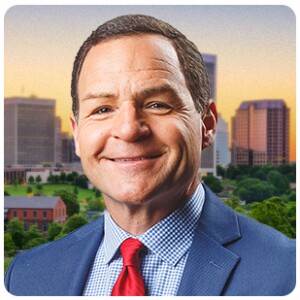CHESTERFIELD COUNTY, Va. -- Tom Hoekstra's back deck serves as Mother Nature's tarmac. Like a big city airport, the arrivals and departures begin shortly after sunrise.
“It keeps me busy. It is music to our ears. It is music to our ears. We love hearing the different sounds," Hoekstra said. "We love the bluebirds. We’ve got baby bluebirds and adult bluebirds all of the time. The pecking order means something out here because there is a pecking order.”
Like an air traffic controller, the birdwatcher from Woodlake admires landings and takeoffs all day.
The 82-year-old and his wife Gio catalog their visitors.
“I’ve started a list and so far that list includes 50 different types of birds,” he said.
His lifelong obsession with flight began before he was born. In 1911, when Tom's father was just nine years old, he witnessed two famous pilots take flight.
“So he climbed a tree and looked over a fence and watched the Wright Brothers flight come in and out,” Tom said. “I think from that moment on he loved airplanes. Aviation was his life."
His dad pursued a career designing aircraft and the teen from Northern Virginia followed his father skyward.
“My dad was an aeronautical engineer,” Tom said. "I’ve got flight in my blood."
But the younger Hoekstra was looking beyond 30,000 feet.
In 1966, the systems engineer joined NASA's Apollo space program. Three years later, he watched an astronaut practice landing on the moon at Langley Field in Virginia.
“At first it didn’t sink in that it was as important as it ended up being,” Tom said.
The 29-year-old recalled sharing advice with the pilot.
“So when you’re coming into the moon, our attitude was let the computer fly the spacecraft as near to the surface of the moon as possible,” he said.
That astronaut was Neil Armstrong.
“He was down to Earth. He respected everything we did. He was a gentleman. An absolute gentleman,” Tom said.
Armstrong would take one small step into the history books.
“I was in awe. He was that type of guy,” Tom said.
On July 16, 1969, Apollo 11 carrying Astronauts Armstrong, Aldrin, and Collins rocketed from the Earth.
“I remember there was a little bit of an edge. They’re going to send this off to the moon,” Tom said.
Four days later, with the world and Tom watching, the lunar module touched down.
“I remember taking notes as they descended to the moon,” Tom said.
NASA's top brass summoned the young engineer to Washington.
“That was a satisfying moment to give them a sense of what actually happened. And how successful Armstrong was in landing that LEM,” Tom said. “It was amazement. Relief. Disbelief that we were able to pull it off."
Tom would work on successive lunar missions including Apollo 15 which he witnessed in person.
“Seeing the trail go up into the sky is something I will never forget,” he said.
More than a half-century after the first lunar landing, this retired engineer reflected on the small role he played.
“250,000 miles away! That is a long way,” laughed Tom.
Tom Hoekstra the birdwatcher who once helped humans spread their wings and plant their feet firmly on the moon.
“Everyone was focused. One hundred percent, 20/20 on a goal. Everyone was working together. Everyone was helping each other overcoming problems. We got it done successfully. Even 52 years later we can be proud of the fact that we did that,” Tom said.







